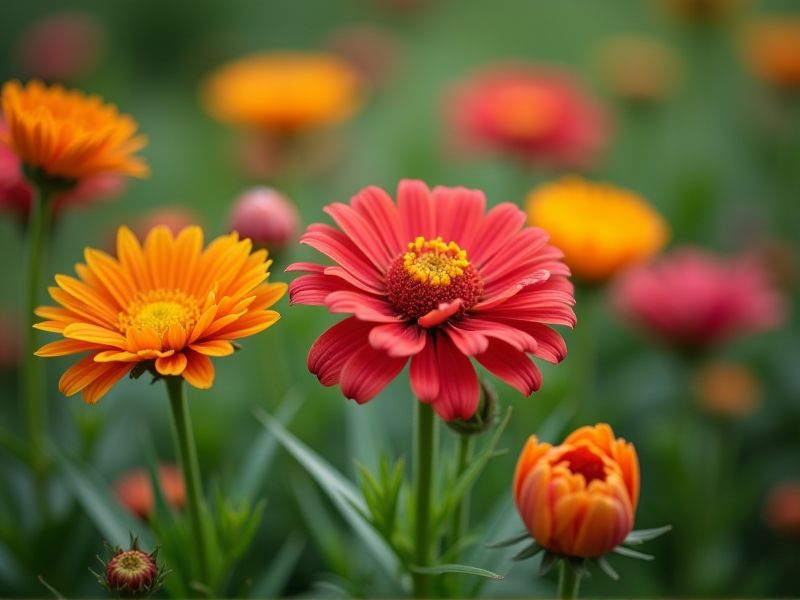
Roses, known for their romantic symbolism, come in various colors, making them a staple in bouquets. Lilies, with their large, fragrant blooms, add an elegant touch and come in a range of varieties, such as Asiatic and Oriental. Sunflowers, characterized by their vibrant yellow petals and large, round heads, evoke feelings of warmth and cheer, often used in casual arrangements. Hydrangeas, available in hues like blue, pink, and white, offer a lush texture and abundant blooms that enhance any floral display. Incorporating seasonal flowers like peonies, which bloom in late spring, can also bring freshness and fragrance to your bouquets.
List of some Flowering plants that are perfect for bouquets
- Rose (Rosa)
- Lily (Lilium)
- Tulip (Tulipa)
- Peony (Paeonia)
- Sunflower (Helianthus)
- Orchid (Orchidaceae)
- Hydrangea (Hydrangea)
- Calla Lily (Zantedeschia)
- Dahlia (Dahlia)
- Gerbera (Gerbera)
Important things about Flowering plants that are perfect for bouquets
Seasonal Availability
Seasonal flowering plants diversify your bouquets throughout the year, with options like tulips in spring, poppies in summer, and dahlias in the fall. In autumn, vibrant chrysanthemums add richness, while winter brings forth elegant white calla lilies and seasonal evergreens. You can enhance your arrangements with fragrant blooms such as lavender in summer or evergreen sprigs in winter, creating a sensory experience. By selecting the right flowers based on their seasonal availability, your bouquets can reflect the beauty of each season while providing a lasting impression.
Flower Longevity
When selecting flowering plants for bouquets, consider varieties known for their longevity, such as chrysanthemums, which can last up to two weeks when properly cared for. Roses, especially hybrid tea roses, are another popular choice, providing a stunning visual impact while maintaining freshness for up to 10 days. Delphiniums add height and vibrancy to arrangements and can stay beautiful for about a week, enhancing your floral display. Incorporating these resilient flowers ensures that your bouquet remains a captivating centerpiece, allowing you to enjoy the beauty of your arrangement for an extended period.
Color Compatibility
When selecting flowering plants for bouquets, consider color compatibility to create visually stunning arrangements. Pale pastels like soft pinks and creams harmonize beautifully with vibrant hues such as deep purples or fiery reds, ensuring a balanced aesthetic. Flowers such as peonies, tulips, and hydrangeas offer a range of colors, making them perfect for layering and texture in your bouquet. Incorporate contrasting shades, like bright yellow sunflowers with rich burgundy dahlias, to create a striking focal point that captivates the eye.
Fragrance
Flowering plants like roses, peonies, and freesia are ideal for creating stunning bouquets due to their vibrant colors and enchanting fragrances. Roses, available in various hues, offer a romantic scent, making them a classic choice for any arrangement. Peonies, known for their lush blooms and sweet aroma, evoke a sense of luxury and elegance, perfect for special occasions. Freesia, with its delicate flowers and citrusy scent, adds a refreshing note to your bouquet, ensuring a delightful olfactory experience.
Foliage Options
When creating stunning bouquets, incorporating foliage options like eucalyptus, ferns, and olive leaves can add texture and depth. Eucalyptus not only offers a fragrant aroma but also features silvery-green leaves that create a beautiful contrast with vibrant blooms. Ferns, such as the sword fern or maidenhair fern, lend a lush, verdant backdrop that enhances the visual appeal of any arrangement. Olive leaves, with their elongated shape and gentle gray-green color, serve as elegant accents that can also evoke a Mediterranean aesthetic in your floral designs.
Size And Shape
When selecting flowering plants for bouquets, consider the size and shape of each bloom to create a visually appealing arrangement. Large, rounded flowers such as peonies or hydrangeas can serve as a focal point, while tall, spiky plants like delphiniums add vertical interest. Smaller blooms, such as ranunculus or waxflower, can fill in gaps and provide texture and dimension. The combination of various shapes and sizes ensures your bouquet will be harmonious and eye-catching, making it perfect for any occasion.
Nutritional Requirements
Flowering plants that are ideal for bouquets often thrive on optimal nutritional requirements, including essential macronutrients such as nitrogen, phosphorus, and potassium. These nutrients promote healthy foliage, vibrant blooms, and strong root systems, ensuring longevity in arrangements. To maintain robust growth, consider incorporating organic fertilizers rich in these elements, along with micronutrients like magnesium and iron, which enhance color and vitality. Your choice of soil should also retain moisture while allowing for good drainage, creating an ideal environment for blooming plants like roses, peonies, and lilies.
Maintenance Needs
Flowering plants ideal for bouquets include roses, peonies, and lilies, each offering unique charm and fragrance. To ensure their longevity in arrangements, regularly trim stems at an angle and change water every few days to prevent bacterial growth. Keeping them in a cool place away from direct sunlight will help maintain their freshness and vibrant colors. Consider using floral preservatives to nourish your blooms, enhancing their life span and beauty in your floral displays.
Flower Symbolism
Flowering plants like roses symbolize love and passion, making them a popular choice for romantic bouquets. Lilies, with their elegant appearance, represent purity and refined beauty, ideal for special occasions like weddings. Sunflowers, known for their vibrant yellow hue, convey adoration and warmth, providing a cheerful touch to any arrangement. You can enhance your bouquet's meaning by incorporating seasonal flowers that reflect personal sentiments or milestones in your life.
Sustainable Sourcing
Sustainable sourcing of flowering plants is essential for creating beautiful bouquets while minimizing environmental impact. Popular choices include locally grown peonies, which bloom in spring and offer lush, fragrant blooms perfect for special occasions. Sunflowers, known for their vibrant yellow petals and long-lasting durability, thrive in various climates and are often cultivated using organic farming practices. When selecting flowers for your arrangements, consider native varieties like coneflowers or black-eyed Susans, as they support local ecosystems and pollinators while providing stunning visual appeal.
